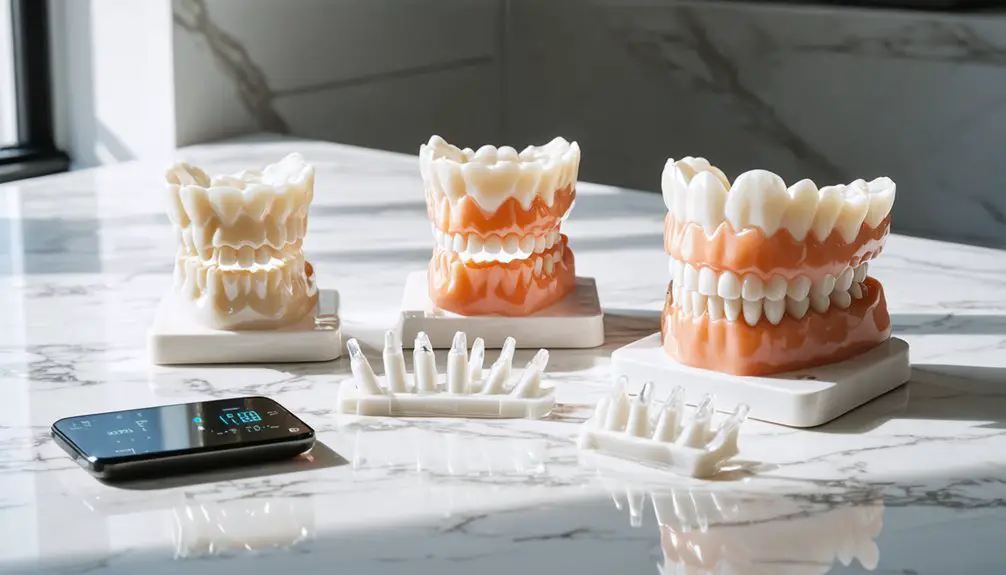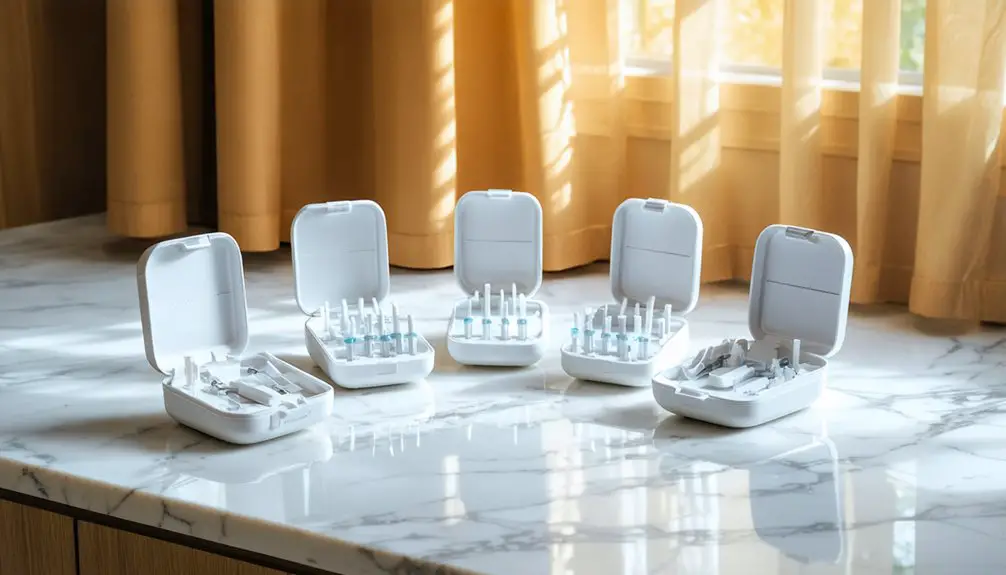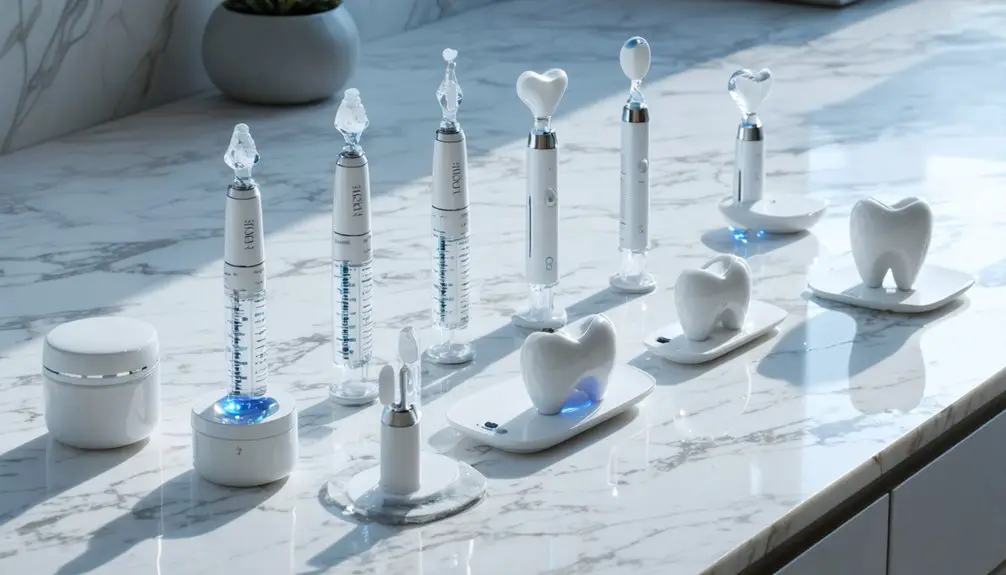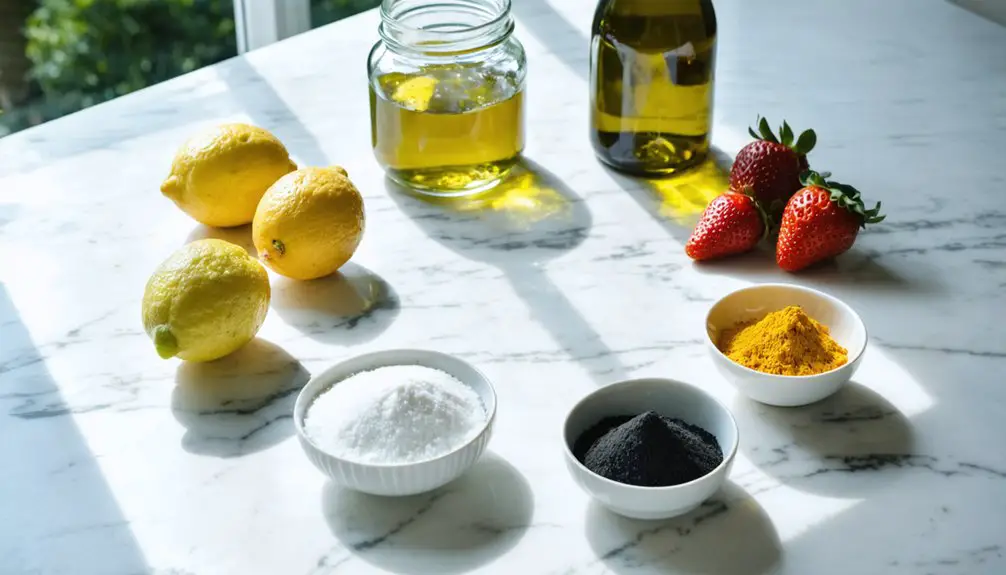You’ll find professional-grade home whitening kits with up to 35% carbamide peroxide most effective for tough stains from coffee, wine, and tobacco. Custom-fitted trays guarantee maximum contact between whitening agents and teeth, delivering faster results than one-size options. LED-enhanced systems can accelerate results, achieving 2.6 shade improvements in 19 days. For sensitive teeth, look for formulas containing potassium nitrate and fluoride. The right combination of technology and active ingredients determines your whitening success.
Key Takeaways
- Professional-grade kits with 10-35% carbamide peroxide offer the strongest stain removal power for deep-set coffee, wine, and tobacco stains.
- Custom-fitted tray systems provide maximum contact between whitening agents and teeth, delivering faster and more effective results than one-size options.
- LED-enhanced whitening systems accelerate results, achieving noticeable improvements in under three weeks compared to traditional methods.
- Combination treatments using whitening strips with specialized toothpaste maximize stain removal effectiveness for tough discoloration.
- Products containing both potassium nitrate and fluoride effectively whiten while minimizing sensitivity for those with reactive teeth.
Why Professional-Grade Whitening Matters at Home
While over-the-counter whitening products flood the market, professional-grade teeth whitening kits offer distinct advantages for at-home use.
These kits deliver higher-quality bleaching agents that consistently lighten teeth by up to 7-10 shades, with results lasting months to years when properly maintained.
Professional teeth whitening kits use advanced bleaching formulas to achieve dramatic, long-lasting results of 7-10 shades lighter with proper maintenance.
Professional evaluations before treatment identify the root causes of discoloration and determine realistic outcomes for your specific case.
This whitening customization includes custom-fitted trays that guarantee maximum contact between the whitening agent and your teeth’s unique morphology.
You’ll benefit from balanced peroxide concentrations that maximize results while minimizing sensitivity. Studies show 10% carbamide peroxide formulations provide effective whitening with significantly reduced discomfort compared to higher concentrations.
The global whitening market continues expanding rapidly as more consumers prioritize dental aesthetics and self-care routines.
Additionally, your dental professional can monitor progress and adjust treatment protocols if needed, protecting you from the risks associated with unregulated products that could damage your enamel or gums.
Understanding Active Ingredients and Their Effects
Professional-grade whitening kits rely on two primary active ingredients: carbamide peroxide and hydrogen peroxide.
These whitening agents work by breaking down chromogens, the colored molecules in your teeth, through an oxidation process. When carbamide peroxide breaks down, it releases about one-third hydrogen peroxide, making it a slower-acting but gentler option.
You’ll find that OTC products contain up to 15% carbamide peroxide or 6% hydrogen peroxide, as regulated by the FDA for safety.
While higher peroxide concentrations can accelerate whitening, they also increase the risk of sensitivity and gum irritation. Custom moldable trays are crucial for maximizing whitening effectiveness by keeping the gel in contact with teeth.
The whitening process opens and closes your enamel matrix structure to remove trapped stains effectively.
It’s essential to recognize that these agents only work on natural teeth, not restorations.
For ideal results with minimal side effects, you should follow the manufacturer’s instructions carefully and consider starting with lower concentrations if you have sensitive teeth.
Comparing LED Technology vs. Traditional Methods
As dental technology continues to evolve, LED whitening systems have emerged as a superior alternative to traditional whitening methods, offering accelerated results through photocatalytic activation.
The LED benefits are substantial: you’ll achieve noticeable whitening in just 30-60 minutes per session, compared to weeks with traditional approaches. Professional treatments use high concentration gel to maximize results. The convenience of LED whitening includes gentle activation that makes it particularly suitable for those with sensitive teeth.
LED systems deliver more uniform results while minimizing tooth sensitivity through controlled, low-heat light activation of peroxide gels. You’ll appreciate the convenience of faster treatments and longer-lasting outcomes.
Traditional drawbacks include prolonged application periods, inconsistent results, and increased tooth sensitivity.
While traditional methods like strips and toothpaste are more accessible, they primarily target surface stains and require persistent daily use.
For best results, LED technology’s precision and efficiency make it a more effective choice for achieving professional-grade whitening at home.
Best Options for Sensitive Teeth and Gums
For those with sensitive teeth and gums, selecting an appropriate whitening solution requires careful consideration of active ingredients and application methods.
Look for products containing potassium nitrate and fluoride, which help block nerve pain signals while strengthening enamel during treatment. Gentle methods include custom-fit trays with low-concentration peroxide gels and sensitive formulations like Crest 3D White Whitestrips Gentle Routine. Using PAP whitening systems offers a peroxide-free alternative that minimizes sensitivity while effectively removing stains. Natural alternatives like baking soda provide a mild abrasive option for surface stains.
Professional guidance guarantees ideal results through controlled application techniques. You’ll want to maintain shorter treatment durations of 15-30 minutes daily and use brush-on applicators to minimize gum contact.
Consider alternating between whitening sessions and desensitizing toothpaste to support enamel health. Products like Sensodyne Extra Whitening and Snow Sensitive Whitening Wand offer effective yet mild solutions for gradual stain removal.
Cost-Effective Solutions for Every Budget
You’ll find teeth whitening solutions across multiple price points, from $5 drugstore options to premium $300 at-home kits with LED technology.
The most cost-effective options typically fall in the $20-50 range, where whitening strips and basic tray kits offer a practical balance between price and results for mild to moderate staining. Over-the-counter products like Crest Whitestrips cost between $25-60 and are widely available. Products like Up&Up strips can whiten teeth nearly 3 shades in just 20 days.
While professional treatments cost $400-1000, many home whitening kits deliver comparable results over time at a fraction of the price, making them an economical choice for long-term maintenance.
Budget-Friendly Whitening Options
The dental market offers four primary categories of affordable teeth whitening solutions that balance cost with effectiveness.
Whitening strips, like Crest 3D White Professional Effects ($45), deliver professional-grade results for moderate stains.
Tray-based systems such as Dr. Collins All White 22% ($20) provide enhanced gel contact through moldable “boil-and-bite” trays.
LED whitening kits, while pricier at $50-$100, offer gentler treatment for sensitive teeth using light-activated peroxide gels.
For basic maintenance, whitening toothpastes under $10 help prevent surface stains and maintain results from other treatments.
For ideal budget whitening with effective results, consider combining approaches.
Using whitening strips or trays alongside specialized toothpaste can maximize stain removal while extending the longevity of your whitening investment.
Best Value Per Treatment
While budget-friendly options abound, calculating value per treatment reveals significant differences in cost-effectiveness among whitening solutions.
You’ll achieve ideal whitening efficacy by selecting products that maximize contact time between peroxide and teeth, particularly those featuring custom-fitted trays or well-adhering strips.
- Custom-fitted trays deliver superior value through even gel distribution and minimal wastage, reducing treatment frequency.
- LED-enhanced systems like Crest 3D Whitestrips Professional Express accelerate results, delivering 2.6 shade improvements in 19 days.
- Products containing 10-35% carbamide peroxide offer effective results with manageable sensitivity when following proper usage protocols.
- Once-daily treatments with strips or trays balance steady progress with ideal product longevity, maximizing your investment while maintaining consistent whitening progress.
Choose systems that minimize sensitivity to avoid additional dental care costs while achieving desired results.
Long-Term Cost Benefits
Understanding long-term cost benefits requires careful analysis of both initial investments and ongoing maintenance expenses across different whitening options.
While professional treatments ($500-$1,000) represent a higher upfront cost, you’ll typically need fewer treatments over time, making them potentially more economical.
In contrast, affordable alternatives like OTC kits ($20-$100) may require increased whitening frequency, leading to cumulative costs that could exceed professional options.
Professional treatments also minimize risks of sensitivity and enamel damage, helping you avoid additional dental expenses.
For ideal cost efficiency, consider your stain severity and dental condition.
If you have mild discoloration, at-home kits might suffice. However, stubborn stains often justify professional treatment’s higher initial investment through longer-lasting results and reduced need for retreatment.
Custom-Fit vs. One-Size-Fits-All Systems

While custom-fit whitening trays offer superior comfort through precise dental impressions that prevent gel leakage and gum irritation, one-size-fits-all systems often create pressure points and uneven coverage.
You’ll achieve faster, more dramatic results with custom trays due to their ideal gel contact and professional-grade concentrations, typically producing visible changes within days versus weeks with generic options.
Though custom systems require a higher initial investment, their enhanced effectiveness, reusability, and dentist-supervised approach deliver better long-term value compared to repeatedly purchasing less effective over-the-counter alternatives.
Comfort and Fit Benefits
Although both custom-fit and one-size-fits-all teeth whitening systems aim to brighten your smile, their comfort levels differ considerably during treatment.
Custom trays provide superior comfort benefits through precise molding to your dental anatomy, ensuring ideal gel distribution and minimizing sensitivity issues.
- You’ll experience a snug, secure fit that prevents gel leakage and reduces gum irritation.
- Your treatment becomes more effective due to uniform whitening gel coverage and consistent contact with teeth.
- You’ll notice less tooth sensitivity compared to generic alternatives, thanks to professional-grade materials and precise fit.
- Your dentist can make adjustments to enhance comfort, addressing your specific needs and concerns.
These comfort advantages translate directly to better treatment outcomes and increased compliance with your whitening regimen.
Treatment Time Vs Results
The time investment required for teeth whitening varies considerably between custom-fit and one-size-fits-all systems, with measurable differences in their outcomes.
Custom-fit systems typically deliver noticeable results within 1-2 weeks through multiple daily sessions or overnight wear. Their professional-grade gels and precise fit guarantee uniform whitening with fewer missed areas.
You’ll experience faster, more substantial shade improvements due to consistent gel contact with your teeth.
One-size-fits-all systems require longer treatment duration, often exceeding two weeks, with daily applications showing moderate effects. Their lower concentration formulas and potentially loose fit can lead to uneven results.
While you’ll need more patience with these systems, they’re still effective for mild stains. However, you may need more frequent maintenance treatments compared to custom solutions to maintain your desired shade.
Cost-Value Comparison Analysis
Investing in teeth whitening requires careful consideration of both initial costs and long-term value between custom-fit and one-size-fits-all systems.
While over-the-counter options offer immediate accessibility at lower prices, custom trays provide superior whitening effectiveness and durability that often justify their higher upfront investment.
- Professional custom trays utilize higher-concentration whitening agents and precise dental impressions, delivering exceptional results in fewer sessions.
- One-size solutions average 40-60% lower initial costs but may require more frequent treatments due to inconsistent coverage.
- Custom-fit systems reduce long-term expenses by minimizing gel waste and preventing the need for repeated applications.
- Professional monitoring with custom trays guarantees safe application of stronger bleaching agents, maximizing your investment while protecting oral health.
Treatment Duration and Expected Results

When starting a teeth whitening regimen, you’ll typically notice initial results within the first week of treatment, though timing varies based on original tooth shade and product concentration.
Treatment consistency and ingredient potency greatly influence the speed and effectiveness of results, with higher concentrations producing faster outcomes.
Standard home whitening kits require 7-14 days of regular use, with maximum effects appearing after 2-4 weeks.
You can safely extend daily application times up to 2 hours for stubborn stains if sensitivity doesn’t occur.
While the whitening effect on enamel is permanent, you’ll likely need maintenance treatments every 3-5 years due to new staining from coffee, wine, or tobacco.
Monthly touch-up sessions can help maintain your results for 6 months or longer.
Safety Measures and Application Tips
Safe and effective teeth whitening requires careful attention to product selection and application protocols. When using home whitening kits, you’ll need to implement proper safety precautions and application techniques to minimize risks while maximizing results.
Achieving optimal teeth whitening results demands diligent product research and strict adherence to safety guidelines when using at-home treatments.
- Choose products with the ADA seal of approval and follow manufacturer instructions precisely regarding duration and frequency of use.
- Conduct a patch test before full application, and discontinue use if you experience burning or severe sensitivity.
- Protect your gums by using custom-fitted trays when possible, and avoid contact between whitening gel and soft tissue.
- Maintain excellent oral hygiene throughout treatment, using fluoride products and avoiding staining substances while following a consistent brushing and flossing routine.
Breaking Down Deep-Set Stains
Deep-set stains from coffee, tea, tobacco, and wine penetrate beneath your tooth’s surface enamel, creating stubborn discoloration that requires targeted chemical intervention.
You’ll need peroxide-based whitening agents that can effectively break down these embedded chromogenic compounds through sustained oxidation processes.
While surface-level stains respond to basic cleaning, these more persistent discolorations from beverages and tobacco require extended contact with professional-grade whitening solutions to achieve noticeable results.
Coffee and Tea Stains
Three primary compounds in coffee and tea – tannins, chromogens, and polyphenols – contribute to stubborn dental stains that penetrate tooth enamel.
You’ll find several effective home remedies and stain prevention techniques to combat these persistent discolorations.
- Mix baking soda into a paste and apply sparingly to avoid enamel erosion while effectively removing surface stains.
- Swish with 3% hydrogen peroxide for one minute, followed by thorough rinsing to break down deeper stains.
- Rinse immediately after consuming coffee or tea, and consider using a straw to minimize contact with teeth.
- Add milk or cream to your beverages, as dairy proteins bind with tannins and reduce staining potential.
For best results, combine these methods with consistent brushing and flossing to maintain a brighter smile while enjoying your daily beverages.
Tobacco Residue Removal
Nicotine and tar from tobacco products create some of the most challenging dental stains to remove, penetrating deep into the enamel’s microscopic pores.
To combat these stubborn discolorations, you’ll need a multi-faceted approach combining professional and at-home treatments. Professional whitening systems using 10% carbamide peroxide in custom trays offer the most effective results, while over-the-counter kits provide gradual improvement.
For natural remedies, consider mixing baking soda with hydrogen peroxide or using mashed strawberries to create gentle whitening pastes. However, exercise caution with acidic or abrasive ingredients to protect your enamel.
Implement stain prevention through consistent oral hygiene: brush twice daily, floss regularly, and rinse immediately after tobacco use. Schedule professional cleanings every six months for ultrasonic scaling and polishing to maintain results and monitor oral health.
Wine-Stained Teeth Solutions
Understanding wine-related tooth discoloration requires examining both red and white wine‘s distinct staining mechanisms.
While red wine’s tannins create immediate surface stains, white wine’s acidity erodes enamel, making your teeth more susceptible to deep-set staining.
For effective wine stain removal while maintaining enamel protection, consider these clinically-proven solutions:
- Utilize professional in-office whitening treatments for deep-set wine stains, especially when over-the-counter products haven’t yielded desired results.
- Apply custom-fitted whitening trays with professional-grade gel for consistent at-home maintenance.
- Implement immediate post-wine rinsing and delayed brushing to prevent tannin adherence without compromising vulnerable enamel.
- Schedule regular professional cleanings to remove surface stains before they penetrate deeper, combining with proper home care for ideal results.
Maintenance and Long-Term Care Strategies
Maintaining the results of teeth whitening requires a thorough approach that combines proper oral hygiene, dietary modifications, and strategic maintenance protocols.
You’ll need to establish consistent maintenance habits, including twice-daily brushing with dentist-approved whitening products and daily flossing to prevent discoloration between teeth.
For best long-term results, incorporate a whitening mouthwash into your routine and use a straw when consuming staining beverages.
Schedule periodic professional touch-ups and use custom-fitted trays rather than over-the-counter alternatives.
Prioritize hydration by drinking plenty of water throughout the day to stimulate saliva production and naturally cleanse your teeth.
Consider incorporating crunchy fruits and vegetables into your diet, while limiting exposure to staining agents like coffee, red wine, and tobacco products.
Frequently Asked Questions
Can I Eat or Drink During the Whitening Treatment Period?
You’ll need to avoid staining foods and drinks during your treatment duration. Stick to water and plain foods to prevent whitening sensitivity and protect your results until the enamel stabilizes.
How Long Do Teeth Whitening Results Typically Last Before Needing Touch-Ups?
Your whitening results can last 6-12 months with proper stain prevention. You’ll notice gradual fading based on your lifestyle, but monthly touch-ups and avoiding staining foods extend these effects considerably.
Will Teeth Whitening Work on Dental Crowns or Veneers?
No, you can’t whiten dental crowns or veneers because they’re made of non-porous dental materials that resist whitening agents. These artificial restorations maintain their original color despite any whitening limitations or treatments.
Should I Brush My Teeth Before or After Applying Whitening Products?
Brush before as pre-whitening preparation to remove surface debris, but don’t brush immediately after application. Wait 30-60 minutes post-whitening care to protect your temporarily sensitive enamel before gentle brushing.
Can Teenagers Safely Use These Teeth Whitening Kits?
You shouldn’t use whitening kits until age 14-16 due to teenage safety concerns. Consult your dentist first, as teens’ thinner enamel increases whitening sensitivity and potential tooth damage risks.
References
- https://www.tribecasmiles.com/best-home-teeth-whitening-products-2025
- https://www.goodhousekeeping.com/health-products/g28723133/best-at-home-teeth-whitening-products/
- https://nhdentistrybeverlyhills.com/press/6-of-the-best-teeth-whitening-kits-in-the-drugstore/
- https://www.cnet.com/health/personal-care/best-teeth-whitening-kits/
- https://pmc.ncbi.nlm.nih.gov/articles/PMC10302806/
- https://www.loudfamilydentistry.com/blog/teeth-whitening-related-statistics-on-effectiveness-and-sensitivity-incidence
- https://www.thedentalspajersey.com/blog/teeth-whitening-statistics-2024
- https://www.suttonpda.com/teeth-whitening-results/
- https://pmc.ncbi.nlm.nih.gov/articles/PMC4058574/
- https://drgeorges.com/dental-white/teeth-whitening-system-comparisons/



